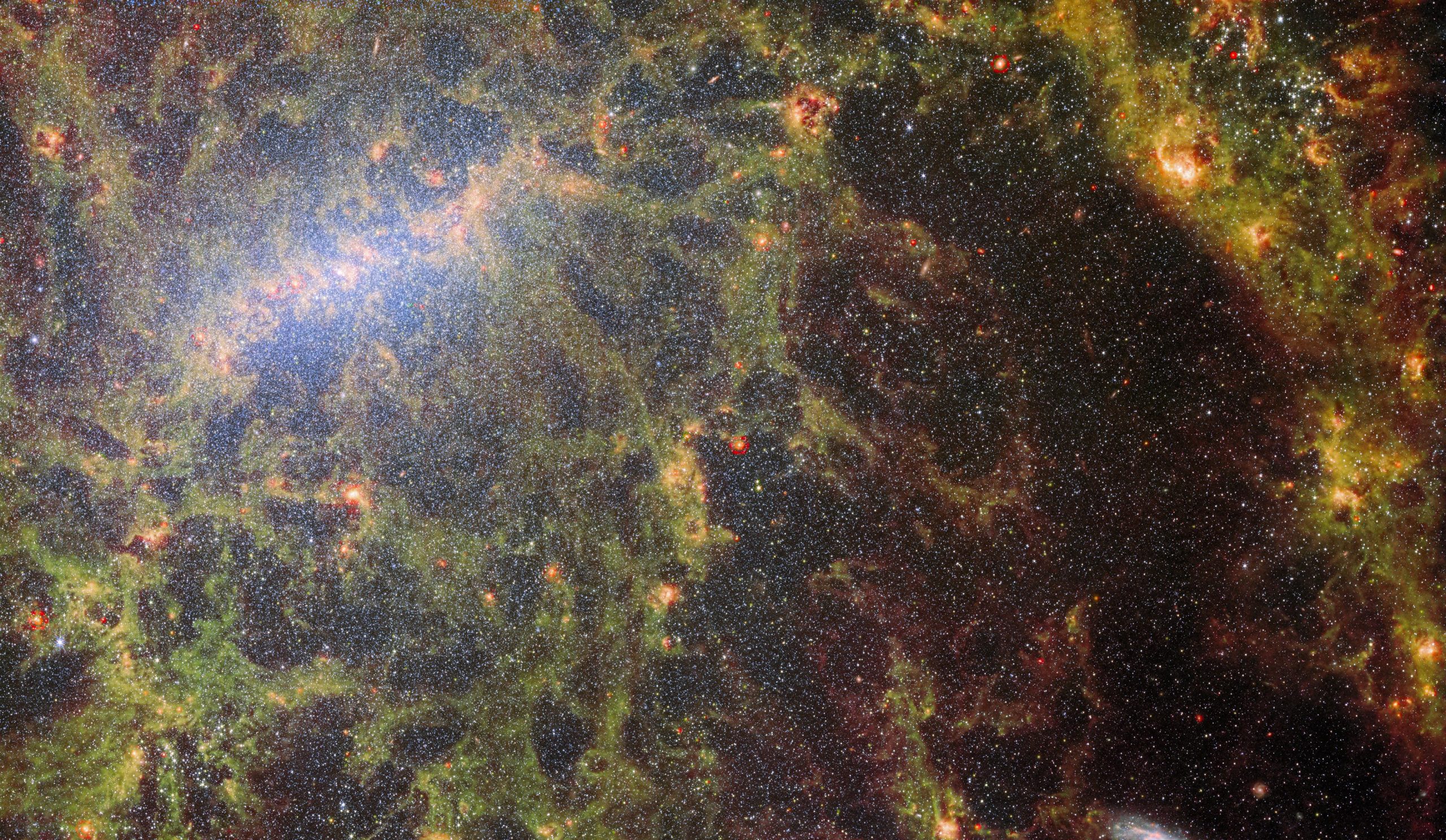Esta imagen de la galaxia espiral barrada NGC 5068 es una combinación de dos de los instrumentos del telescopio espacial James Webb, MIRI y NIRCam. Crédito: ESA/Webb, NASA, CSA, J. Lee y el equipo PHANGS-JWST
James Webb Space Telescope has captured a detailed image of the barred spiral galaxy NGC 5068. Part of a project to record star formation in nearby galaxies, this initiative provides significant insights into various astronomical fields. The telescope’s ability to see through gas and dust, typically hiding star formation processes, offers unique views into this crucial aspect of galactic evolution.
A delicate tracery of dust and bright star clusters threads across this image from the James Webb Space Telescope. The bright tendrils of gas and stars belong to the barred spiral galaxy NGC 5068, whose bright central bar is visible in the upper left of this image – a composite from two of Webb’s instruments. NASA Administrator Bill Nelson revealed the image on June 2 during an event with students at the Copernicus Science Centre in Warsaw, Poland.

In this image of the barred spiral galaxy NGC 5068, from the James Webb Space Telescope’s MIRI instrument, the dusty structure of the spiral galaxy and glowing bubbles of gas containing newly-formed star clusters are particularly prominent. Three asteroid trails intrude into this image, represented as tiny blue-green-red dots. Asteroids appear in astronomical images such as these because they are much closer to the telescope than the distant target. As Webb captures several images of the astronomical object, the asteroid moves, so it shows up in a slightly different place in each frame. They are a little more noticeable in images such as this one from MIRI, because many stars are not as bright in mid-infrared wavelengths as they are in near-infrared or visible light, so asteroids are easier to see next to the stars. One trail lies just below the galaxy’s bar, and two more in the bottom-left corner. Credit: ESA/Webb, NASA & CSA, J. Lee and the PHANGS-JWST Team
NGC 5068 lies around 20 million light-years from Earth in the constellation Virgo. This image of the central, bright star-forming regions of the galaxy is part of a campaign to create an astronomical treasure trove, a repository of observations of star formation in nearby galaxies. Previous gems from this collection can be seen here (IC 5332) and here (M74). These observations are particularly valuable to astronomers for two reasons. The first is because star formation underpins so many fields in astronomy, from the physics of the tenuous plasma that lies between stars to the evolution of entire galaxies. By observing the formation of stars in nearby galaxies, astronomers hope to kick-start major scientific advances with some of the first available data from Webb.

This view of the barred spiral galaxy NGC 5068, from the James Webb Space Telescope’s NIRCam instrument, is studded by the galaxy’s massive population of stars, most dense along its bright central bar, along with burning red clouds of gas illuminated by young stars within. This near-infrared image of the galaxy is filled by the enormous gathering of older stars which make up the core of NGC 5068. The keen vision of NIRCam allows astronomers to peer through the galaxy’s gas and dust to closely examine its stars. Dense and bright clouds of dust lie along the path of the spiral arms: These are H II regions, collections of hydrogen gas where new stars are forming. The young, energetic stars ionize the hydrogen around them, creating this glow represented in red. Credit: ESA/Webb, NASA & CSA, J. Lee and the PHANGS-JWST Team
The second reason is that Webb’s observations build on other studies using telescopes including the Hubble Space Telescope and ground-based observatories. Webb collected images of 19 nearby star-forming galaxies which astronomers could then combine with Hubble images of 10,000 star clusters, spectroscopic mapping of 20,000 star-forming emission nebulae from the Very Large Telescope (VLT), and observations of 12,000 dark, dense molecular clouds identified by the Atacama Large Millimeter/submillimeter Array (ALMA). These observations span the electromagnetic spectrum and give astronomers an unprecedented opportunity to piece together the minutiae of star formation.
With its ability to peer through the gas and dust enshrouding newborn stars, Webb is particularly well-suited to explore the processes governing star formation. Stars and planetary systems are born amongst swirling clouds of gas and dust that are opaque to visible-light observatories like Hubble or the VLT. The keen vision at infrared wavelengths of two of Webb’s instruments — MIRI (Mid-Infrared Instrument) and NIRCam (Near-Infrared Camera) — allowed astronomers to see right through the gargantuan clouds of dust in NGC 5068 and capture the processes of star formation as they happened. This image combines the capabilities of these two instruments, providing a truly unique look at the composition of NGC 5068.
The James Webb Space Telescope stands as the apex of space science observatories worldwide. Tasked with demystifying enigmas within our own solar system, Webb will also extend its gaze beyond, seeking to observe distant worlds orbiting other stars. In addition to this, it aims to delve into the cryptic structures and the origins of our universe, thereby facilitating a deeper understanding of our position within the cosmic expanse. The Webb project is an international endeavor spearheaded by NASA, conducted in close partnership with the European Space Agency (ESA) and the Canadian Space Agency.

«Jugador. Wannabe evangelista de la cerveza. Practicante de la cultura pop. Amante de los viajes. Defensor de las redes sociales».

/cdn.vox-cdn.com/uploads/chorus_asset/file/24043392/chromecast.jpg)





More Stories
Los casos de dengue alcanzan los 5,2 millones en las Américas mientras el brote supera el récord anual, dice la Organización Panamericana de la Salud
El núcleo de Plutón probablemente fue creado por una antigua colisión
La Organización Mundial de la Salud dice que el riesgo de que la gripe aviar se transmita a los humanos es una «gran preocupación». Gripe aviar